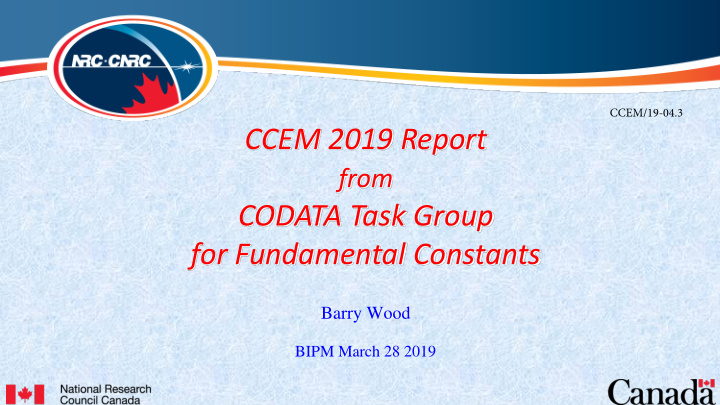



CCEM/19-04.3 CCEM 2019 Report from CODATA Task Group for Fundamental Constants Barry Wood BIPM March 28 2019
Outline • CODATA TGFC • TGFC’s Role in SI Redefinition • The 2017 special LSA • Final Values of Planck, Avogadro & Boltzmann constants • Is the TGFC out of a job? • Comments about the Fine structure & Rydberg constants • The 2018 LSA.
ICSU & CODATA There is a group that has been setting these values for over 50 years! CODATA Task Group on Fundamental Constants - established in 1969 - “to periodically provide the scientific and technological communities with a self-consistent set of internationally recommended values of the basic constants and conversion factors of physics and chemistry based on all of the relevant data available at a given point in time.” The Task Group sanctions the data selection and methodology of the adjustment of the recommended values of the constants.
CODATA – Committee on Data for Science and Technology (CODATA) – was established in 1966 - is an interdisciplinary Scientific Committee of the International Council for Science (ICSU), which works to improve the quality, reliability, management, and accessibility of data of importance to all fields of science and technology. – CODATA Task Group on Fundamental Constants - established in 1969 - “to periodically provide the scientific and technological communities with a self-consistent set of internationally recommended values of the basic constants and conversion factors of physics and chemistry based on all of the relevant data available at a given point in time.” – The Task Group sanctions the data selection and methodology of the adjustment of the recommended values of the constants.
TGFC Members • K. Pachucki, University of Warsaw. Poland (Chair) • D. B. Newell, NIST, USA (CoChair) • F. Cabiati, Istituto Nazionale di Ricerca Metrologica, Italy • E. de Mirandés, BIPM, France • A. Surzhykov, PTB, Germany • K. Fujii, National Metrology Institute of Japan, Japan • S. G. Karshenboim, D. I. Mendeleyev Institute of Metrology, Russia • H. Margolis, NPL, UK • P. J. Mohr, NIST, USA • E. Tiesinga, NIST, USA • F. Nez, Laboratoire Kastler-Brossel, France • M. Wang, IMP, China • B. M. Wood, National Research Council, Canada • J. Qu, National Institute of Metrology, China • T. J. Quinn, CBE FRS, France (Emeritus) • B. N. Taylor, NIST, USA (Emeritus)
How to get the values URL: physics.nist.gov/constants
SI Redefinition In essence, the change involves exactly fixing the values of 7 constants that set the scale of the SI units : – speed of light E = m c 2 c Dn – ground state hyperfine splitting frequency of 133 Cs – Planck constant E = h h e – the elementary charge charge on a proton k – Boltzmann constant E = k T N A – Avogadro constant number of entities in a mole K cd – luminous efficacy of 540 × 10 12 Hz radiation c , h , e , k , N A are fundamental physical constants
CODATA TGFC’s Role CODATA TGFC has been recommending self-consistent values of the fundamental constants since 1973. The CCU decided that the TGFC would prepare the values for redefinition. The CCU and CIPM approved those numbers. The task group prepared a Special LSA for the SI redefinition. This will be followed by a full LSA using the revised SI and its uncertainties
CGPM 2011: Resolution A - now with final numbers • takes note of the intention of the International Committee for Weights and Measures to propose a revision to the SI as follows: • the International System of Units , the SI, will be the system of units in which: the ground state hyperfine splitting frequency of the caesium 133 atom Dn ( 133 Cs) hfs • is exactly 9 192 631 770 hertz • the speed of light in vacuum c is exactly 299 792 458 metre per second, the Planck constant h is exactly 6.626 070 15 × 10 -34 joule second, • the elementary charge e is exactly 1.602 176 634 × 10 -19 coulomb, • the Boltzmann constant k is exactly 1.380 649 × 10 -23 joule per kelvin, • the Avogadro constant N A is exactly 6.022 140 76 × 10 23 reciprocal mole, • the luminous efficacy K cd of monochromatic radiation of frequency 540 × 10 12 Hz is • exactly 683 lumen per watt,
… And the Resulting Value for h
Is TGFC Out of a Job ? • With Planck, Avogadro, elementary charge and Boltzmann fixed, what is left? • Rydberg, fine structure constant, Newtonian gravitational constant and many other derived and lesser known constants including 0 .
The proton charge radius controversy: T a significant correction for the Rydberg
Timeline The 2018 Least Squares Adjustment is underway. Submission of new data is closed and analysis is proceeding. Both the Rydberg and fine structure constant are expected to change, but not enough to affect electrical measurements (< 3 × 10 -10 ). Public release of the 2018 LSA is anticipated around May 20, 2019
Recommend
More recommend